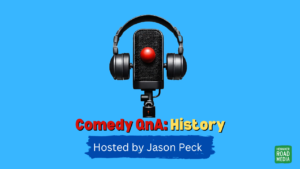Let me start by saying that I don’t believe there is a single secret, tool, or formula that will make you a successful humorous speaker or help you learn stand-up comedy.
But there are methods that allow you to harness the sense of humour you already possess. That, plus a little bit of effort.
I think it’s fair to say that every successful humorous speaker (and stand-up comedian) has strategies that, in some way, allow them to deliver a hilarious act on the platform.
According to the author of the Stand-up Comedy Fast Start Guide, Steve Roye, humorous speakers (whether they are aware of it or not) are usually applying 3 Essential Strategies to get the results they want on stage.
They are able to do the following:
1. Produce large quantities of hilarious comedic material in the shortest possible time.
2. Test, edit, and refine their comedic material in the fewest performances possible.
3. Develop and maintain ultimate stage comfort.
It’s exactly the same for anybody looking to learn stand-up comedy. I am inclined to agree with him on this, as it outlines a basic blueprint for success and for developing a solid act as a speaker who incorporates humour into speeches and presentations.
I’m sure you’ll agree that if you have these bases covered, you have the greatest chance for success as a humorous speaker.
Steve also says that speaking professionals that maintain 45 seconds of laughter for each 5 minutes of presenting are kicking the proverbial posterior (my words not his).
Whereas, generally, stand-up comedians consistently succeed, or “kill”, their audiences get a minimum of 4 to 6 laughs per minute throughout their entire act. An important differenciation if you want to learn stand-up comedy.
I believe: “the funnier you are, the more money you make!” Yes, there is a certain amount of promotion and marketing tactics involved, but lets be honest if you don’t have “the product” (your speech) then you are essentially selling the sizzle without delivering the steak!
However, you must know how to get these strategies to work for you. The good news is, it can be done and there is a system that will work to help you accomplish your comedy goals as a humorous speaker.
I stumbled across the website for the Stand-up Comedy Fast Start Guide and I debated whether to purchase the e-books as I already had countless books on writing and performing comedy.
Being such “a student of comedy”, I’m a hard audience as I know and have tried the majority of approaches to humorous writing out there.
But sometimes you just have to move out your comfort zone and step off the comedy precipice.
I have to say that i have learnt more about the comedic writing and performing process since reading the “Fast Start Guide” than I have ever learnt anywhere else.
For my money the “Fast Start Guide” and the “Comedy Timing Secrets” bonus e-book are worth the cost alone. But you also get the very valuable “How to Read an Audience” e-book too.
I devoured these books in one sitting. That’s something that doesn’t often happen as I have fairly bad reading habits.
Although I think it is fair to say that comedy timing and the ability to read an audience comes with experience on stage. There are obviously certain techniques you can acquire if you want to learn stand-up comedy.
That said, the information in both those e-books alone detail exactly what you should be looking out for with an audience and what you can do to help you with your timing.
It puts into words what others know instinctively and that’s got to be a good thing?
The thing I always worry about is whether a guide such as the Stand-up Comedy Fast Start Guide is going to explain to me why something is funny.
You’ve probably heard the comparison of analyzing why a joke (or routine) is funny to dissecting a frog; a handful of people find it interesting but ultimately both the joke and the frog die.
Well, I was pleased to discover that it doesn’t do this at all.
The downside to this guide is that the main e-book is under 40 pages in length and it doesn’t provide you with any real life war stories or examples of these techniques in action. I feel that that’s important if you want to learn stand-up comedy.
It would be good to know if the author can actually “walk the talk”.
It also, doesn’t make explicit how these techniques apply to the professional speaker and their need to add humour to their speeches. The book, itself, is specifically aimed at the stand-up comedian.
In order to work this out a certain amount of thought is requried as you essentially have to use the speech you already have for a basis for adding the required punchlines.
That said the techniques work for me, once i am able to set aside the part of me that tries to think up jokes.
If that has been your previous way of doing things then setting that part of your brain aside in order to capture your unique sense of humour will be a challenge.
The best thing for me about the Stand-up Comedy Fast Start Guide is that it made passionate about the whole process again.
I actually look forward to writing and I hadn’t done that for a long time. So don’t delay, go to this website right now:
Top Comedy Secrets.
Note: There are affiliate links on this page which means that if you purchase the product through my link I will get paid a commission. This is how I help pay the bills. If you’re happy with that please go ahead and use my link to make your purchase.



